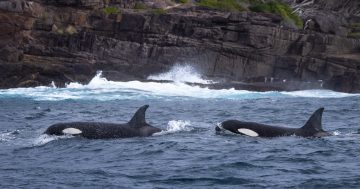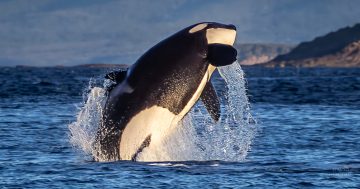
Large pods of killer whales are a rare sight off the South Coast. Photo: Dave Harvey.
A Batemans Bay angler got the surprise of his life when a pod of between 50 and 100 killer whales surrounded his boat during a weekend fishing trip.
Jayde Theodore, who operates Blacklip Wetsuits, has been fishing, abalone diving and surfing off the Batemans Bay coast since he was eight years old, and had never encountered an orca, so when he saw the massive pod, he said he was blown away.
“I looked up from sending a text message on my phone and they were everywhere,” he said.
“They were really active and jumping right out of the water.
“One popped up right next to the boat and turned on its side and was looking up at me – I was in awe really.
“In 23 years, I’ve never seen a killer whale before.”
Jayde was tuna fishing with his cousin Ryan Connell about 10 nautical miles east of Batemans Bay at 8 am on Saturday 22 July when they spotted the mammals heading south.
He said the whales ranged in size and there looked to be some juveniles among the pod.
“There was a broad range of sizes, from five feet to 25 feet. The really big ones had dorsal fins about one and a half metres long,” he said.
“I’ve had mixed reports about the species. I don’t know if they were adults and juveniles, or two different species travelling together.”
After viewing Jayde’s footage, Killer Whales Australia described the encounter as a “rare sighting of what appears to be Antarctic Type C killer whales”.
They said the event represented just the seventh record of Type C killer whales off non-Antarctic Australian coastal waters.
Type C, also known as Ross Sea killer whales, are the smallest species of orcas and live in larger groups than the others. They are primarily white and medium grey, with a dark grey dorsal cape and yellow-tinged patches. Adult males can reach lengths of about six metres.
Jayde said a number of seals were swimming with the pod, which he thought was strange because orcas usually ate seals.
Typically seen off Eastern Antarctica in thick pack ice, Type C orcas have been seen eating Antarctic toothfish, but it is still unknown if they survive solely on fish. They are known to migrate from Antarctica to New Zealand and back.
Jayde said he had seen many humpback whales while out fishing this season, and there had also been reports of large schools of yellow fin and blue fin tuna off Batemans Bay over winter.
The exciting encounter follows recent orca sightings off Merimbula and Tathra during July.
According to whale and dolphin conservation group WDC, there are five main species, or ecotypes, of killer whales found in the Southern Hemisphere. The whales differ in size, appearance, prey preferences, foraging techniques, dialects, behaviours, and social groups.
Type A, the largest orcas grow up to 9.5 metres long and prefer the open areas of the Southern Ocean. They primarily hunt minke whales, following their migration in and out of Antarctic waters.
Type B (large), also called Pack Ice orcas, hunt seals around the Antarctic continent and are famous for a hunting technique whereby they use their tails and bodies to create waves to wash seals off pack ice.
Rounding out the species are Type B (small) and Type D killer whales.
Original Article published by Katrina Condie on About Regional.














